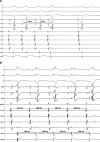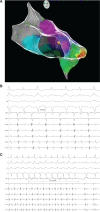An Incessant Tachycardia: What Is the Mechanism?
- PMID: 33959407
- PMCID: PMC8095334
- DOI: 10.19102/icrm.2021.120407
An Incessant Tachycardia: What Is the Mechanism?
Abstract
A 39-year-old man presented with lifelong palpitations, a mildly reduced left ventricular ejection fraction, and incessant tachycardia. Electrocardiography revealed a regular, one-to-one supraventricular tachycardia with superiorly directed P-waves and a long R-P interval. The differential diagnosis of the tachycardia, response to invasive electrophysiologic maneuvers, and treatment with catheter ablation are discussed.
Keywords: Activation mapping; orthodromic reciprocating tachycardia; permanent junctional reciprocating tachycardia; radiofrequency ablation.
Copyright: © 2021 Innovations in Cardiac Rhythm Management.
Conflict of interest statement
The authors report no conflicts of interest for the published content.
Figures



References
-
- Ho RT, Frisch DR, Pavri BB, Levi SA, Greenspon AJ. Electrophysiological features differentiating the atypical atrioventricular node-dependent long RP supraventricular tachycardias. Circ Arrhythm Electrophysiol. 2013;6(3):597–605. [CrossRef] [PubMed] - DOI - PubMed
-
- Critelli G, Gallagher JJ, Monda V, Coltorti F, Scherillo M, Rossi L. Anatomic and electrophysiologic substrate of the permanent form of junctional reciprocating tachycardia. J Am College Cardiol. 1984;4(3):601–610. [CrossRef] [PubMed] - DOI - PubMed
-
- Meiltz A, Weber R, Halimi F, et al. Permanent form of junctional reciprocating tachycardia in adults: peculiar features and results of radiofrequency catheter ablation. EP Europace. 2006;8:21–28. [CrossRef] [PubMed] - DOI - PubMed
Publication types
LinkOut - more resources
Full Text Sources
